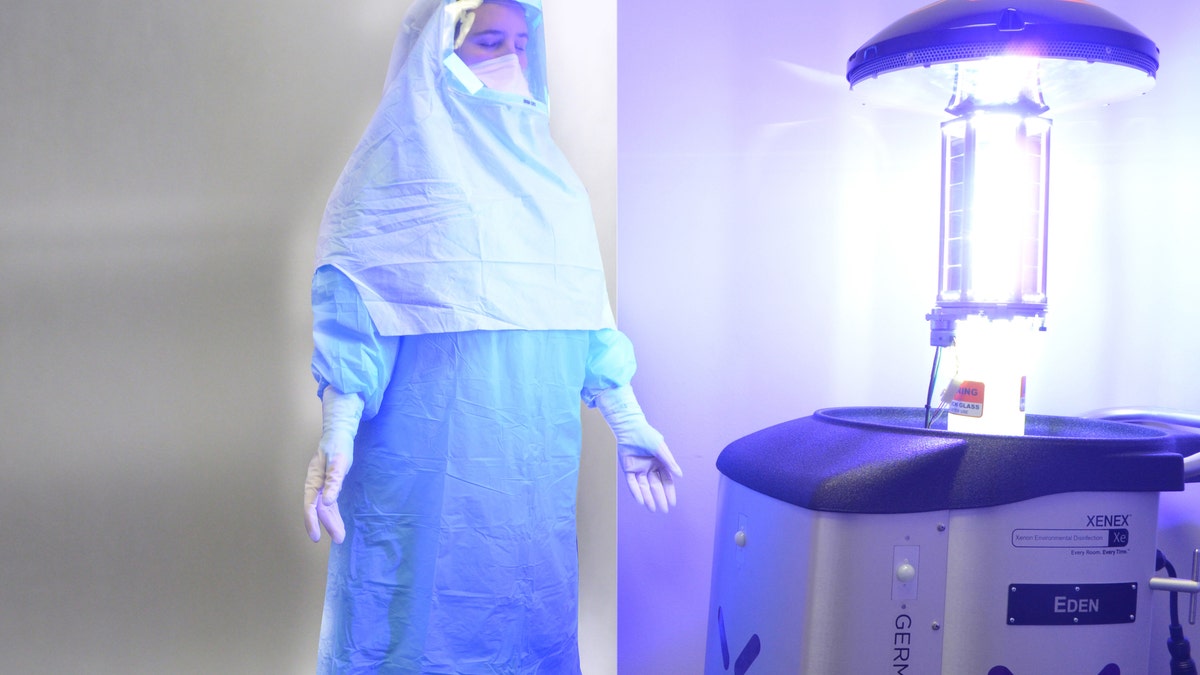
(Xenex)
Ebola’s not the only infection feared by hospitals now - new technology strengthens sanitization, zaps growing number of healthcare acquired infections (HAIs).
A trip to the hospital these days may make you sick. Though it sounds like a paradox, doctors are increasingly concerned that their patients will catch so-called healthcare associated infections (HAIs), not just head-line grabbers like the Ebola virus. Less famous microbes, like Clostridium difficile, or C. Diff., a bug that irritates the intestines, cause dreadful cases of diarrhea when, for example, unwittingly transferred from one sick patient, to a doctor’s hands, and then to another patient.
While washing or sanitizing one’s hands before and after each patient encounter is common practice in clinics and hospitals, it’s no longer enough to kill these persistent microbes. So hospitals are increasing the number of times they require doctors and nurses to wash their hands, and have developed fancy new mathematical formulas, algorithms, and new sanitation devices to track cleanliness and decrease the dangers for patients during their hospital stays.
What’s more, microbial resistant materials such as Noble Biomaterials' X-STATIC are coming online. These materials are used for hospital scrubs and lab coats, as well as patient privacy curtains. X-STATIC can reduce bacteria on the surface of fabrics in the healthcare environment, according to a spokesman for Noble Biomaterials.
According to The Centers for Disease Control and Prevention (CDC), one in 25 hospital patients comes down with an infection picked up while being treated. In 2011, an estimated 722,000 patients were infected during their hospital stay, and about than 75,000 died from healthcare-related infections. That’s more than 200 deaths per day.
Low Ebola risk
“While the risk of someone contracting the Ebola virus in the U.S. is quite low, the risk is much higher that they'll suffer an infection from one of the superbugs (resistant to antibiotics) that are prevalent in our hospitals right now,” says Melinda Hart, a marketing manager of Xenex, maker of a germ-zapping robot called Eden which uses ultraviolet light to kill nasty microbes on the likes of countertops and other surfaces. Eden is in use at 250 hospitals across the U.S., including major academic medical centers like Northwestern Memorial Hospital, in downtown Chicago. “Americans are in much greater danger from germs that already exist in our hospitals than they are from Ebola,” added Hart.
The anti-microbial technologies are being deployed not just in emergency rooms, but in intensive care units and even public waiting areas, killing MRSA, Methicillin Resistant Staphylococcus Aureaus, and other dangerous superbugs, experts told FoxNews.com.
Tracking tools
Ignaz Semmelweis, an obstetrician working at Vienna General Hospital in the 19th century, first observed that by washing his hands with bleach before he touched his patients, he could reduce their mortality rate by 90 percent.
Doctors and nurses typically use the “in and out method,” cleaning their hands only upon entry and exit of a patient’s room, despite the fact that they can touch multiple bacteria-laden surfaces during the encounter. Compliance with hand washing protocols is usually on the honor system, though some hospitals have had an aide follow doctors and check on the list on a clipboard the number of times they wash per visit.
Dr. John Jernigan, a CDC epidemiologist, said at a recent conference that physicians and nurses wash their hands probably only 50 percent of the time, and this has “been a very chronic and difficult problem to get adherence levels up as high as we would want them."
There are now high-tech ways monitor and report hand hygiene events to improve compliance and lower infection spread. One of these is the DebMed Group Monitoring System. The system uses an evidence-based algorithm to pre-determine the expected number of times hospital staff should have washed and/or sanitized their hands - hand hygiene opportunities. The DebMed Group Monitoring System calculates a compliance rate for each specific unit in real-time by dividing the actual hand hygiene events, or the numerator, by the expected number of opportunities for hand hygiene, or the denominator.
Another monitoring technology is being used by SSM St. Mary's Health Center in Richmond Heights, Mo., near St. Louis. The hospital has been a test site for a system developed by Ann Arbor, Mich.-based Biovigil. A flashing light on a badge turns green when a clinician’s hands are clean, red if they're not. The technology tracks each hand-cleaning opportunity — and records the successes and the flops. Hospital officials say compliance is up to 97 percent now, and they are shooting for 100 percent in the future.
Wireless technology is in the mix, too. The maker of Purell hand sanitizer, Akron, Ohio-based GOJO Industries, has created an electronic compliance monitoring system using wireless technology to track when hand sanitizer dispensers are used. The SmartLink system gives data on high-and low-compliance areas of each hospital where it is deployed.
However, there’s one caveat for the sanitization technologies - a paper in a medical journal recently noted that there’s not a lot of data about whether the detection devices themselves contain bugs. So further investigation is needed, experts told FoxNews.com.




















